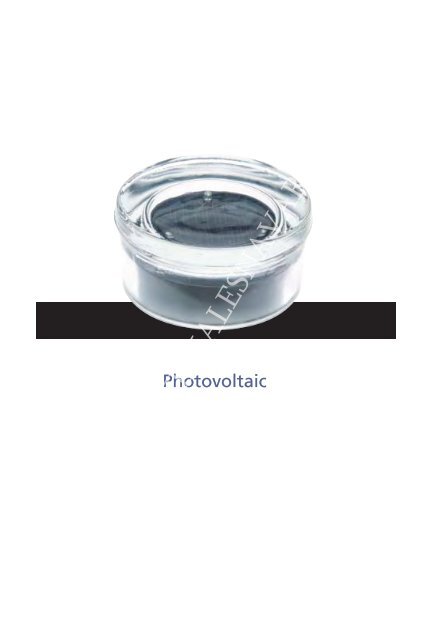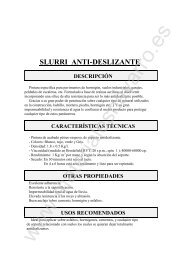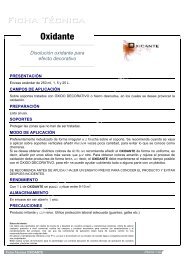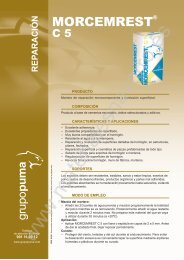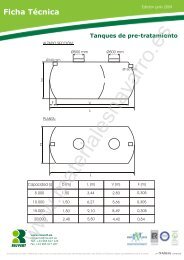ficha de aplicación
ficha de aplicación
ficha de aplicación
You also want an ePaper? Increase the reach of your titles
YUMPU automatically turns print PDFs into web optimized ePapers that Google loves.
Photovoltaic
Il mattone di vetro che si ricarica con il sole<br />
Glass blocks with sun powered illumination<br />
La Brique <strong>de</strong> verre qui se recharge avec le soleil<br />
El ladrillo <strong>de</strong> vidrio que se recarga con el sol<br />
Der Glasziegel, <strong>de</strong>r sich durch die Sonne auflädt
Innovación y soluciones<br />
ecológicas para la<br />
arquitectura<br />
Innovation und<br />
ökologische Lösungen<br />
für die Architektur<br />
Un mañana sostenible se construye hoy, a través <strong>de</strong> la<br />
innovación y el <strong>de</strong>sarrollo <strong>de</strong> soluciones <strong>de</strong> alta eficiencia<br />
energética para la arquitectura y la construcción.<br />
Ninguna otra empresa se ha comprometido tanto en este frente<br />
como Seves Glassblock, lí<strong>de</strong>r internacional en la producción <strong>de</strong><br />
ladrillos <strong>de</strong> vidrio y primera empresa <strong>de</strong>l mundo en introducir, en<br />
2009, la revolucionaria tecnología “Energy Saving”, el ladrillo <strong>de</strong><br />
vidrio para el ahorro energético.<br />
Seves introduce ahora la colección Photovoltaic, con la que alcanza<br />
otro importante objetivo en la búsqueda <strong>de</strong> soluciones ecológicas<br />
para la arquitectura.<br />
Ein nachhaltiges Morgen muss man schon heute<br />
aufbauen, nämlich durch Innovation und die<br />
Entwicklung von Lösungen mit hoher Energieeffizienz<br />
für die Architektur und <strong>de</strong>n Hausbau.<br />
Auf dieser Front hat sich kein an<strong>de</strong>res Unternehmen so eingesetzt<br />
wie Seves Glassblock, das international bei <strong>de</strong>r Herstellung von<br />
Glasziegeln führend und weltweit das erste Unternehmen ist,<br />
das 2009 die revolutionieren<strong>de</strong> “Energy Saving“-Technologie<br />
eingeführt hat, <strong>de</strong>n Energiespar-Glasziegel.<br />
Mit <strong>de</strong>r Einführung <strong>de</strong>r Kollektion Photovoltaic erreicht Seves<br />
heute einen weiteren wichtigen Meilenstein bei <strong>de</strong>r Suche nach<br />
ökologischen Lösungen für die Architektur.<br />
<br />
5
8<br />
L’éclairage avec la<br />
puissance du soleil<br />
L’éclairage avec la puissance du soleil: les briques <strong>de</strong> verre Photovoltaic<br />
transforment le verre, un matériau déjà en soi écologique, en un<br />
produit nouveau pour l’architecture à même <strong>de</strong> créer <strong>de</strong>s applications<br />
d’éclairage et d’économie d’énergie liées à <strong>de</strong>s possibilités infinies <strong>de</strong><br />
personnalisation.<br />
Ilumina con la<br />
potencia <strong>de</strong>l sol<br />
Beleuchtung mit <strong>de</strong>r<br />
Kraft <strong>de</strong>r Sonne<br />
La collection Photovoltaic se compose <strong>de</strong> briques en verre<br />
piétonnières, lumineuses, à basse tension, alimentées par l’énergie<br />
solaire. Ces nouvelles briques offrent une alternative à <strong>de</strong>s solutions<br />
<strong>de</strong> corps éclairés câblés et frayent le chemin à <strong>de</strong> nouvelles possibilités<br />
d’économie d’énergie.<br />
Il est désormais plus facile, rapi<strong>de</strong> et économique d’ajouter un éclairage<br />
doux à <strong>de</strong>s environnements extérieurs et créer <strong>de</strong>s motifs lumineux<br />
uniques pour les planchers et les passerelles, car il n’y a pas besoin <strong>de</strong><br />
canalisations, installation <strong>de</strong> câbles électriques et d’entretien.<br />
La partie intérieure <strong>de</strong>s briques Photovoltaic accueille <strong>de</strong>s panneaux<br />
solaires qui emmagasinent l’énergie pendant le jour, puis la distribuent<br />
pendant la nuit sous forme d’éclairage, grâce aux LED à haut ren<strong>de</strong>ment.<br />
La gamme Photovoltaic est spécialement conçu pour <strong>de</strong>s applications<br />
extérieures commerciales, <strong>de</strong>s structures publiques ou rési<strong>de</strong>ntielles,<br />
telles que : <strong>de</strong>s passages piétons, trottoirs, balcons, cours, quais, jardins,<br />
ainsi que pour tout type <strong>de</strong> paroi et panneau extérieurs.<br />
Ilumina con la potencia <strong>de</strong>l sol: los ladrillos <strong>de</strong> vidrio Photovoltaic<br />
transforman el vidrio, un material ya <strong>de</strong> por sí ecológico, en un<br />
nuevo producto para la arquitectura, capaz <strong>de</strong> crear aplicaciones <strong>de</strong><br />
iluminación y <strong>de</strong> ahorro energético vinculadas a infinitas posibilida<strong>de</strong>s<br />
<strong>de</strong> personalización.<br />
La colección Photovoltaic está formada por ladrillos <strong>de</strong> vidrio<br />
transitables, luminosos, <strong>de</strong> bajo voltaje, alimentados con energía<br />
solar. Estos nuevos ladrillos ofrecen una alternativa a las soluciones <strong>de</strong><br />
cuerpos iluminantes cableados y abren el camino a nuevas posibilida<strong>de</strong>s<br />
<strong>de</strong> ahorro energético.<br />
Añadir una iluminación difusa para ambientes externos, crear motivos<br />
luminosos únicos para suelos y pasarelas es ahora más fácil, rápido y<br />
económico, ya que no habrá necesidad <strong>de</strong> canalizaciones, instalación<br />
<strong>de</strong> cables eléctricos ni mantenimiento.<br />
Los ladrillos Photovoltaic contienen en su interior paneles solares que<br />
almacenan energía durante el día y la restituyen <strong>de</strong> noche en forma <strong>de</strong><br />
iluminación con ayuda <strong>de</strong> LED <strong>de</strong> alta eficiencia.<br />
Photovoltaic ha sido proyectado expresamente para aplicaciones<br />
comerciales externas, estructuras públicas o resi<strong>de</strong>nciales, como: pasos<br />
peatonales, aceras, balcones, patios, embarca<strong>de</strong>ros, jardines, así como<br />
para toda clase <strong>de</strong> pare<strong>de</strong>s o paneles externos.<br />
Beleuchtung mit <strong>de</strong>r Kraft <strong>de</strong>r Sonne: Die Photovoltaic-Glasziegel<br />
verwan<strong>de</strong>ln das Glas, ein an sich schon ökologisches Material, in ein<br />
neues Produkt für die Architektur, mit <strong>de</strong>m man Beleuchtungs- und<br />
Energiesparanwendungen schaffen kann. Und dies mit unendlich<br />
vielen individuellen Gestaltungsmöglichkeiten.<br />
Die Kollektion Photovoltaic besteht aus begehbaren, mit<br />
Nie<strong>de</strong>rspannung leuchten<strong>de</strong>n Glasziegeln, die von Sonnenenergie<br />
gespeist wer<strong>de</strong>n. Diese neuen Ziegeln bieten eine Alternative zu<br />
Lösungen mit verkabelten Leuchtkörpern und eröffnen <strong>de</strong>n Weg zu<br />
neuen Energiesparmöglichkeiten.<br />
Das Hinzufügen einer diffusen Beleuchtung für Außenbereiche und<br />
das Schaffen von einzigartigen leuchten<strong>de</strong>n Motiven für Pflasterungen<br />
und Stege ist jetzt viel leichter, rascher und wirtschaftlicher möglich,<br />
da keine Kabelkanäle und keine Installation von Stromkabeln mehr<br />
notwendig ist und keine Wartung anfällt.<br />
Die Photovoltaic-Ziegel haben in ihrem Inneren Solarplatten,<br />
die während <strong>de</strong>s Tages Energie speichern und diese nachts über<br />
hocheffiziente LEDs wie<strong>de</strong>r als Beleuchtung abgeben.<br />
Photovoltaic wur<strong>de</strong> eigens für gewerbliche Außenanwendungen,<br />
öffentliche o<strong>de</strong>r Wohngebäu<strong>de</strong> entwickelt, wie etwa:<br />
Fußgängerpassagen, Gehwege, Balkone, Innenhöfe, Stege, Gärten,<br />
sowie für je<strong>de</strong> Art von Wand o<strong>de</strong>r Platte im Freien.
11<br />
Altas prestaciones<br />
técnicas<br />
Los ladrillos ofrecen altas prestaciones técnicas gracias a la potente<br />
batería <strong>de</strong> litio (LiFePo4 3.2V) y a los diodos LED <strong>de</strong> alta luminosidad<br />
(3000-3500MCD).<br />
Hohe technische<br />
Leistungen<br />
La energía recogida a través <strong>de</strong>l panel solar se acumula en la batería<br />
<strong>de</strong> alta capacidad que alimenta las luces LED durante la noche. El<br />
ladrillo se ilumina automáticamente gracias a un sensor crepuscular<br />
cuando la luminosidad <strong>de</strong>l ambiente externo <strong>de</strong>scien<strong>de</strong> por <strong>de</strong>bajo<br />
<strong>de</strong> 30lux. Cuando se alcanzan los 60lux, o cuando la carga <strong>de</strong> la<br />
batería <strong>de</strong>scien<strong>de</strong> por <strong>de</strong>bajo <strong>de</strong> 2.4V, las luces Led se apagan<br />
automáticamente.<br />
Para un uso i<strong>de</strong>al <strong>de</strong> Photovoltaic es necesario situarlo en el exterior,<br />
en una posición expuesta al sol para garantizar la recarga completa<br />
<strong>de</strong> la batería.<br />
Die Ziegel haben dank <strong>de</strong>r leistungsstarken Lithiumbatterie<br />
(LiFePO4 3,2V) und <strong>de</strong>r LED-Dio<strong>de</strong>n mit hoher Leuchtkraft (3000-<br />
3500MCD) hohe technische Leistungen.<br />
Die über die Solarplatte gesammelte Energie wird im<br />
Hochleistungsakkumulator gespeichert, <strong>de</strong>r die LED-Leuchten<br />
nachts speist. Der Ziegel leuchtet dank eines Dämmerungssensors<br />
automatisch auf, wenn die Helligkeit <strong>de</strong>r Außenumgebung<br />
unter 30Lux absinkt. Wer<strong>de</strong>n 60Lux erreicht, o<strong>de</strong>r wenn <strong>de</strong>r<br />
Batteriela<strong>de</strong>stand unter 2,4V absinkt, schalten sich die Led-Lichter<br />
automatisch ab.<br />
Für eine optimale Nutzung von Photovoltaic muss man ihn im Freien<br />
an einer Stelle anbringen, wo er <strong>de</strong>r Sonne ausgesetzt ist, um ein<br />
vollständiges Aufla<strong>de</strong>n <strong>de</strong>r Batterie zu gewährleisten.
12<br />
Dati tecnici<br />
Technical Data<br />
Caractéristiques techniques<br />
Características técnicas<br />
Technische Details<br />
PANNELLO SOLARE<br />
SOLAR PANEL<br />
PANNEAU SOLAIRE<br />
PANEL SOLAR<br />
SOLARPLATTE<br />
Temperatura di Utilizzo / Operating Temperature / Température<br />
d’utilisation/ Temperatura <strong>de</strong> uso / Betriebstemperaturen<br />
BATTERIA<br />
BATTERY<br />
BATTERIE<br />
BATERÍA<br />
BATTERIE<br />
Tempo di caricamento<br />
Charge Frequency<br />
Temps <strong>de</strong> chargement<br />
Tiempo <strong>de</strong> carga<br />
La<strong>de</strong>zeit<br />
Tempo di scaricamento<br />
Discharge Frequency<br />
Temps <strong>de</strong> déchargement<br />
Tiempo <strong>de</strong> <strong>de</strong>scarga<br />
Entla<strong>de</strong>zeit<br />
LED / DEL<br />
Colore luce / Light Color / Couleur lumière / Color <strong>de</strong> luz /Lichtfarbe<br />
Tempo di funzionamento<br />
Operating Time<br />
Temps <strong>de</strong> fonctionnement<br />
Tiempo <strong>de</strong> funcionamiento<br />
Betriebszeit<br />
MATERIALE<br />
MATERIAL<br />
MATÉRIAU<br />
MATERIAL<br />
MATERIAL<br />
Dimensioni / Dimensions / Dimensions / Medidas / Abmessungen<br />
Peso / Weight / Poids / Peso / Gewicht<br />
B R11/6 Clearview<br />
0,13 W/4V Durata <strong>de</strong>l prodotto= +10 anni<br />
0,13 W/4V Lifespan= +10 years<br />
0,13 W/4V Durée du produit= +10 ans<br />
0,13 W/4V Duración <strong>de</strong>l producto= +10 años<br />
0,13 W/4V Lebensdauer <strong>de</strong>s Produkts= +10 Jahre<br />
LiFePO4 3.2V/1100mAh (durata=max 2.000 cicli)<br />
LiFePO4 3.2V/1100mAh (lifespan=max 2.000 cycles)<br />
LiFePO4 3,2V/1100mAh (durée=max 2 000 cycles)<br />
LiFePO4 3.2V/1100mAh (duración=máx 2.000 ciclos)<br />
LiFePO4 3,2V/1100mAh (Lebensdauer=max 2.000 Zyklen)<br />
325mAh in 10 ore<br />
325mAh in 10 hours<br />
325mAh en 10 heures<br />
325mAh en 10 horas<br />
325mAh in 10 Stun<strong>de</strong>n<br />
23-30mA per ONU Periodo di 14 ore (o fino a 2,4V)<br />
23-30mA in 14 hours (or until 2.4V)<br />
23-30mA pour ONU Pério<strong>de</strong> <strong>de</strong> 14 heures (ou jusqu’à 2,4V)<br />
23-30mA por ONU Período <strong>de</strong> 14 horas (o hasta 2,4V)<br />
23-30mA pro ONU Zeit von 14 Std. (o<strong>de</strong>r bis 2,4V)<br />
3 LED XZ-B5LPW4E-2D, 3000-3500MCD<br />
Cool white<br />
14 ore al Giorno / 50.000 ore di vita<br />
14 hours a day / 50.000 total hours of life<br />
14 heures par jour / 50.000 heures <strong>de</strong> durée <strong>de</strong> vie<br />
14 horas al día / 50.000 horas <strong>de</strong> vida<br />
14 Std pro Tag / 50.000 Stun<strong>de</strong>n Lebensdauer<br />
Semiguscio piastrella di vetro<br />
Half-shell glass block<br />
Demi-coquille carreau en verre<br />
Mitad-azulejo <strong>de</strong> vidrio<br />
Halbschalen-Glasplatte<br />
ø11,7x6cm<br />
1,1 kg<br />
N. pezzi/m 2 / N. Pieces/m 2 / Nbre pièces/m 2 / N. piezas/m 2 / Anz.<br />
49<br />
Stücke / m 2<br />
Resistenza agli sbalzi termici<br />
Secondo EN 1051/1 (30°C)<br />
Thermal Shock Resistance<br />
Based on EN 1051/1 (30°C)<br />
Résistance aux chocs thermiques<br />
Selon EN 1051/1 (30°C)<br />
Resistencia a los saltos térmicos<br />
Según EN 1051/1 (30°C)<br />
Beständigkeit gegen Temperaturstürze<br />
Gemäß EN 1051/1 (30°C)<br />
Resistenza a rottura KN<br />
Resistance to breakage (KN)<br />
Résistance-limite (KN)<br />
Resistencia a la rotura (KN)<br />
Bruchfestigkeit (KN)<br />
-20°C / +70°C<br />
Secondo EN 1051/1 (>7,5 N)<br />
Based on EN 1051/1 (>7,5 N)<br />
Selon EN 1051/1 (>7,5 N)<br />
Según EN 1051/1 (>7,5 N)<br />
Gemäß EN 1051/1 (> 7,5 N)<br />
<br />
*I dati riportati nella tabella sono puramente indicativi <strong>de</strong>i valori reali, raggiunti nelle condizioni i<strong>de</strong>ali, con la massima esposizione al sole ed<br />
un’angolazione corretta.<br />
*The information inclu<strong>de</strong>d in this table is purely indicative of the values obtained in i<strong>de</strong>al conditions, during which time the glass block was<br />
positioned in the sun, with the correct angle, to ensure maximum exposure.<br />
*Les données indiquées dans le tableau sont purement indicatives <strong>de</strong>s valeurs réelles, obtenues dans <strong>de</strong>s conditions idéales, avec l’exposition<br />
maximale au soleil et un angle correct.
13<br />
B1111 / 6 Clearview<br />
0,12 W/4V Durata <strong>de</strong>l prodotto= +10 anni<br />
0,12 W/4V Lifespan= +10 years<br />
0,12 W/4V Durée du produit= +10 ans<br />
0,12 W/4V Duración <strong>de</strong>l producto= +10 años<br />
0,12 W/4V Lebensdauer <strong>de</strong>s Produkts= +10 Jahre<br />
-20°C / +70°C<br />
LiFePO4 3.2V/1100mAh (durata =max 2.000 cicli)<br />
LiFePO4 3.2V/1100mAh (lifespan=max 2.000 cycles)<br />
LiFePO4 3,2V/1100mAh (durée=max 2 000 cycles)<br />
LiFePO4 3.2V/1100mAh (duración=máx 2.000 ciclos)<br />
LiFePO4 3,2V/1100mAh (Lebensdauer=max 2.000 Zyklen)<br />
325mAh in 10 ore<br />
325mAh in 10 hours<br />
325mAh en 10 heures<br />
325mAh en 10 horas<br />
325mAh in 10 Stun<strong>de</strong>n<br />
25-32mA per ONU Periodo di 12 ore (o fino a 2,4V)<br />
25-32mA in 12 hours (or until 2.4V)<br />
25-32mA pour ONU Pério<strong>de</strong> <strong>de</strong> 12 heures (ou jusqu’à 2,4V)<br />
25-32mA por ONU Período <strong>de</strong> 12 horas (o hasta 2,4V)<br />
25-32mA pro ONU Zeit von 12 Std. (o<strong>de</strong>r bis 2,4V)<br />
B 1919/7 Circles<br />
0,4 W/4V Durata <strong>de</strong>l prodotto= +10 anni<br />
0,4 W/4V Lifespan= +10 years<br />
0,4 W/4V Durée du produit= +10 ans<br />
0,4 W/4V Duración <strong>de</strong>l producto= +10 años<br />
0,4 W/4V Lebensdauer <strong>de</strong>s Produkts= +10 Jahre<br />
LiFePO4 3.2V/1400mAh (durata=max 2.000 cicli)<br />
LiFePO4 3.2V/1400mAh (lifespan=max 2.000 cycles)<br />
LiFePO4 3,2V/1400mAh (durée=max 2 000 cycles)<br />
LiFePO4 3.2V/1400mAh (duración=máx 2.000 ciclos)<br />
LiFePO4 3,2V/1400mAh (Lebensdauer=max 2.000 Zyklen)<br />
1000mAh in 10 ore<br />
1000mAh in 10 hours<br />
1000mAh en 10 heures<br />
1000mAh en 10 horas<br />
1000mAh in 10 Stun<strong>de</strong>n<br />
76-84mA per ONU Periodo di 13 ore (o fino a 2,4V)<br />
76-84mA in 14 hrs. (or until 2.4V)<br />
76-84mA pour ONU Pério<strong>de</strong> <strong>de</strong> 13 heures (ou jusqu’à 2,4V)<br />
76-84mA por ONU Período <strong>de</strong> 13 horas (o hasta 2,4V)<br />
76-84mA pro ONU Zeit von 13 Std. (o<strong>de</strong>r bis 2,4V)<br />
4 LED XZ-B5LPW4E-2D, 3000-3500MCD 8 LED XZ-B5LPW4E-2D, 3000-3500MCD<br />
Cool white<br />
12 ore al Giorno / 50.000 ore di vita<br />
12 hours a day / 50.000 total hours of life<br />
12 heures par jour / 50.000 heures <strong>de</strong> durée <strong>de</strong> vie<br />
12 horas al día / 50.000 horas <strong>de</strong> vida<br />
12 Std pro Tag / 50.000 Stun<strong>de</strong>n Lebensdauer<br />
Semiguscio piastrella di vetro<br />
Half-shell glass block<br />
Demi-coquille carreau en verre<br />
Mitad-azulejo <strong>de</strong> vidrio<br />
Halbschalen-Glasplatte<br />
11,7x11,7x6 cm<br />
Cool white<br />
13 ore al Giorno / 50.000 ore di vita<br />
13 hours a day / 50.000 total hours of life<br />
13 heures par jour / 50 000 heures <strong>de</strong> durée <strong>de</strong> vie<br />
13 horas al día / 50.000 horas <strong>de</strong> vida<br />
13 Std pro Tag / 50.000 Stun<strong>de</strong>n Lebensdauer<br />
Semiguscio piastrella di vetro<br />
Half-shell glass block<br />
Demi-coquille carreau en verre<br />
Mitad-azulejo <strong>de</strong> vidrio<br />
Halbschalen-Glasplatte<br />
19x19x7 cm<br />
1,25 kg 2,7 kg<br />
49 21<br />
Secondo EN 1051/1 (30°C)<br />
Based on EN 1051/1 (30°C)<br />
Selon EN 1051/1 (30°C)<br />
Según EN 1051/1 (30°C)<br />
Gemäß EN 1051/1 (30°C)<br />
Secondo EN 1051/1 (>7,5 N)<br />
Based on EN 1051/1 (>7,5 N)<br />
Selon EN 1051/1 (>7,5 N)<br />
Según EN 1051/1 (>7,5 N)<br />
Gemäß EN 1051/1 (> 7,5 N)<br />
-20°C / +70°C<br />
Secondo EN 1051/1 (30°C)<br />
Based on EN 1051/1 (30°C)<br />
Selon EN 1051/1 (30°C)<br />
Según EN 1051/1 (30°C)<br />
Gemäß EN 1051/1 (30°C)<br />
Secondo EN 1051/1 (>7,5 N)<br />
Based on EN 1051/1 (>7,5 N)<br />
Selon EN 1051/1 (>7,5 N)<br />
Según EN 1051/1 (>7,5 N)<br />
Gemäß EN 1051/1 (> 7,5 N)<br />
<br />
*Los datos recogidos en la tabla tienen carácter orientativo con respecto a los valores reales, obtenidos en las condiciones i<strong>de</strong>ales, con la máxima<br />
exposición al sol y una correcta angulación.<br />
* Die in <strong>de</strong>r Tabelle angegebenen Daten sind nur als Anhaltspunkte für die wirklichen Werte zu verstehen, sie wur<strong>de</strong>n unter i<strong>de</strong>alen<br />
Bedingungen mit maximaler Sonneneinstrahlung im richtigen Winkel erreicht.
14<br />
NORMATIVE & GARANZIA<br />
I mattoni in vetro Photovoltaic sono stati prodotti seguendo le normative di settore:<br />
• EN 1051/1-“Glass in building: glass block and glass pavers”<br />
• DIN 18175/77-“Glasbausteine: Anfor<strong>de</strong>rungen, Prüfung” (mattoni in vetro per costruzioni: prove, caratteristiche)<br />
• DIN 4243/78-“Betongläser: Anfor<strong>de</strong>rungen, Prüfung” (mattoni in vetro per costruzioni: prove, caratteristiche)<br />
Non avendo Seves nessuna possibilità di controllo sulle condizioni di posa, le modalità di esecuzione, l’utilizzo <strong>de</strong>lla<br />
manodopera competente nell’installazione e il corretto uso <strong>de</strong>i materiali accessori, nessuna garanzia può essere estesa<br />
al mattone di vetro dopo la posa in opera <strong>de</strong>llo stesso.<br />
Seves garantisce il funzionamento <strong>de</strong>ll’impianto elettronico al interno <strong>de</strong>l mattone -solo nei casi in cui il mattone non sia<br />
danneggiato a causa di installazione non corretta- per un periodo di 3 anni.<br />
STANDARDS & GUARANTEE<br />
Photovoltaic glass blocks are produced according to the following norms:<br />
• EN 1051/1-“Glass in building: glass block and glass pavers”<br />
• DIN 18175/77-“Glasbausteine: Anfor<strong>de</strong>rungen, Prüfung” (Glass blocks for building: tests; features)<br />
• DIN 4243/78-“Betongläser: Anfor<strong>de</strong>rungen, Prüfung” (Glass blocks for floors: tests, features)<br />
Since Seves has no way of controlling the installation conditions and methods, the use of appropriately skilled labour,<br />
or the proper use of the accessory materials, there is no guarantee for glass blocks after installation and/or assembly.<br />
Seves does guarantee the proper function of the electrical <strong>de</strong>vice within the glass block for a three year period, and only<br />
in cases in which the damage incurred is not a result of incorrect installation methods.<br />
RÉGLEMENTATIONS & GARANTIE<br />
Les briques <strong>de</strong> verre Photovoltaic ont été fabriquées conformément aux réglementations:<br />
• EN 1051/1-“Glass in building: glass block and glass pavers” (verre pour la construction - pavés <strong>de</strong> verre et blocs <strong>de</strong> verre)<br />
• DIN 18175/77-“Glasbausteine: Anfor<strong>de</strong>rungen, Prüfung“ (briques <strong>de</strong> verre pour les constructions: essais, caractéristiques)<br />
• DIN 4243/78- “Betongläser: Anfor<strong>de</strong>rungen, Prüfung” (briques <strong>de</strong> verre pour les constructions: essais, caractéristiques)<br />
Étant donné que Seves n’a aucune possibilité <strong>de</strong> contrôler les conditions <strong>de</strong> pose, les modalités d’exécution, l’utilisation<br />
<strong>de</strong> la main-d’œuvre qualifiée pour l’installation et l’usage correct <strong>de</strong>s accessoires, aucune garantie ne peut être appliquée<br />
à la brique <strong>de</strong> verre après la pose <strong>de</strong> cette <strong>de</strong>rnière.<br />
Seves garantit le fonctionnement du système électronique à l’intérieur <strong>de</strong> la brique, seulement si cette <strong>de</strong>rnière n’est pas<br />
endommagée à cause d’une installation erronée, pendant une pério<strong>de</strong> <strong>de</strong> 3 ans.<br />
NORMATIVAS & GARANTÍA<br />
Los ladrillos <strong>de</strong> vidrio Photovoltaic se han fabricado siguiendo las normativas <strong>de</strong> sector:<br />
• EN 1051/1-“Glass in building: glass block and glass pavers”<br />
• DIN 18175/77-“Glasbausteine: Anfor<strong>de</strong>rungen, Prüfung” (ladrillos <strong>de</strong> vidrio para construcciones: pruebas, características)<br />
• DIN 4243/78- “Betongläser: Anfor<strong>de</strong>rungen, Prüfung” (ladrillos <strong>de</strong> vidrio para construcciones: pruebas, características)<br />
Dado que Seves no tiene posibilidad <strong>de</strong> controlar las condiciones <strong>de</strong> colocación, los modos <strong>de</strong> ejecución, la capacitación<br />
<strong>de</strong> la mano <strong>de</strong> obra que interviene en la instalación y el uso correcto <strong>de</strong> los materiales accesorios, no pue<strong>de</strong>n aplicarse<br />
ningún tipo <strong>de</strong> garantías al ladrillo <strong>de</strong> vidrio una vez puesto en obra.<br />
Seves garantiza el funcionamiento <strong>de</strong>l sistema electrónico interno <strong>de</strong>l ladrillo, sólo si el ladrillo no ha sufrido daños por<br />
instalación incorrecta, durante un período <strong>de</strong> 3 años.<br />
NORMEN & GARANTIE<br />
<br />
Die Glasziegel Photovoltaic wer<strong>de</strong>n nach folgen<strong>de</strong>n Branchennormen hergestellt:<br />
• EN 1051/1-“Glass in building: glass block and glass pavers”<br />
• DIN 18175/77- “Glasbausteine: Anfor<strong>de</strong>rungen, Prüfung” (Glasbausteine: Tests, Eigenschaften)<br />
• DIN 4243/78- “Betongläser: Anfor<strong>de</strong>rungen, Prüfung” (Glasbausteine: Tests, Eigenschaften)<br />
Da Seves keine Kontrollmöglichkeit für die Bedingungen <strong>de</strong>r Verlegung, die Ausführungsmodalitäten, <strong>de</strong>n Einsatz von<br />
kompetenten Arbeitskräften bei <strong>de</strong>r Installation und für die korrekte Anwendung <strong>de</strong>r Zubehörmaterialien hat, kann<br />
keine Garantie auf <strong>de</strong>n Glasziegel nach <strong>de</strong>r Verlegung <strong>de</strong>sselben geleistet wer<strong>de</strong>n.<br />
Seves garantiert für das Funktionieren <strong>de</strong>r elektronischen Anlage im Inneren <strong>de</strong>s Ziegels nur in <strong>de</strong>n Fällen, in <strong>de</strong>nen <strong>de</strong>r<br />
Ziegel nicht durch eine nicht korrekte Installation beschädigt ist. Die Garantielaufzeit beträgt 3 Jahre.
15
16
17<br />
INSTALLAZIONE<br />
I mattoni di vetro Photovoltaic possono essere installati in tutte le applicazioni orizzontali e su tutte le superficicemento,<br />
asfalto, legno, pietra, etc - sia come singolo mattone che come parti di un pannello.<br />
Singoli mattoni:<br />
Per installare singoli mattoni di vetro Photovoltaic, bisogna innanzitutto rimuovere il magnete presente sul retro <strong>de</strong>l<br />
mattone mediante il distacco <strong>de</strong>ll’apposita linguetta a<strong>de</strong>siva. Dopo averlo posizionato nello spazio <strong>de</strong>stinato alla posa,<br />
fissarlo con malta cementizia o apposito a<strong>de</strong>sivo ed infine sigillarne il perimetro con materiali elastici a base siliconica o<br />
poliuretanica.<br />
Pannello:<br />
Per installare Photovoltaic come parte di un pannello, seguire le istruzioni di installazione tradizionali con malta<br />
cementizia e calcolare le corrette dimensioni e la capacità di carico <strong>de</strong>l pannello. Seves glassblock raccomanda una fuga<br />
di almeno 3 cm tra i mattoni.<br />
Per entrambi sistemi di posa, il fondo <strong>de</strong>lla casseratura <strong>de</strong>ve risultare perfettamente piano e allo stesso livello <strong>de</strong>lla<br />
struttura portante d’appoggio perimetrale. Su quest’ultima va collocata una guaina orizzontale di scorrimento e un<br />
giunto verticale di dilatazione/assestamento. Qualora le strutture siano esposte alla pioggia, occorre sigillare i giunti di<br />
dilatazione evitando materiali stesi o fissati a caldo per non causare shock termici e dilatazioni pericolose per gli elementi<br />
in vetro.<br />
Smaltimento: Non smaltire il mattone di vetro Photovoltaic nei cestini <strong>de</strong>i rifiuti domestici, e verificare le norme locali<br />
per ulteriori informazioni sullo smaltimento <strong>de</strong>i prodotti.<br />
INSTALLATION<br />
Photovoltaic glass blocks can be installed as a single block or part of a panel into almost any horizontal application or<br />
surface: concrete, asphalt, wood or stone.<br />
Single glass blocks:<br />
To install Photovoltaic as a single glass block, first remove the magnet from the back of the block, then position it<br />
into the prepared space and secure it with cement mortar or a suitable glue. Seal the edges with an elastic silicone or<br />
polyurethane based sealant.<br />
Panel installation:<br />
To install Photovoltaic as part of a panel, first calculate the correct panel dimensions and carrying capacity, then follow<br />
instructions for traditional cement and mortar installation. Seves recommends a joint of at least 3 cm between the<br />
blocks.<br />
For both installation methods, please note that the bottom of the casing must be perfectly flat and level with the<br />
perimeter supporting structure. A horizontal slip sheath and vertical expansion/settling joint must also be placed on<br />
the perimeter supporting structure. If the structures are to be waterproofed, avoid sealing the expansion joints with<br />
heat fixed or spread materials in or<strong>de</strong>r to prevent thermal shock and dilatation which can be hazardous to glass blocks.<br />
Disposal: Do not discard Photovoltaic glass blocks in household waste receptacles. Please check local regulations for<br />
information about the correct way to dispose of these products in your area.<br />
INSTALLATION<br />
Les briques <strong>de</strong> verre Photovoltaic peuvent être installées dans toutes les applications horizontales et sur toutes les<br />
surfaces (ciment, asphalte, bois, pierre, etc.), aussi bien comme brique simple que comme partie d’un panneau.<br />
Briques simples:<br />
pour installer <strong>de</strong>s briques <strong>de</strong> verre simples Photovoltaic, il faut avant tout retirer l’aimant présent sur le verso <strong>de</strong> la<br />
brique, en détachant la languette adhésive correspondante. Après l’avoir positionnée dans l’espace <strong>de</strong>stiné à la pose, la<br />
fixer avec du mortier <strong>de</strong> ciment ou un adhésif prévu à cet effet, puis sceller son périmètre avec <strong>de</strong>s matériaux élastiques<br />
à base <strong>de</strong> silicone ou polyuréthane.<br />
Panneau:<br />
pour installer Photovoltaic comme partie d’un panneau, suivre les instructions d’installation traditionnelles avec mortier<br />
<strong>de</strong> ciment et calculer les dimensions correctes, ainsi que la capacité <strong>de</strong> charge du panneau. Seves Glassblock recomman<strong>de</strong><br />
une ligne <strong>de</strong> séparation d’au moins 3 cm entre les briques.<br />
<br />
Pour les <strong>de</strong>ux systèmes <strong>de</strong> pose, le fond du coffrage doit être parfaitement plat et au même niveau <strong>de</strong> la structure<br />
portante d’appui du périmètre. Placer sur cette <strong>de</strong>rnière une gaine horizontale <strong>de</strong> coulissement et un joint vertical<br />
<strong>de</strong> dilatation/tassement. Si les structures sont exposées à la pluie, il faut sceller les joints <strong>de</strong> dilatation, en évitant les<br />
matériaux étalés ou fixés à chaud pour ne pas causer <strong>de</strong> chocs thermiques et <strong>de</strong>s dilatations dangereuses pour les<br />
éléments en verre.<br />
Élimination: ne pas éliminer la brique <strong>de</strong> verre Photovoltaic avec les déchets domestiques, et vérifier les normes locales<br />
pour <strong>de</strong> plus amples informations sur l’élimination <strong>de</strong>s produits.
18<br />
INSTALACIÓN<br />
Los ladrillos <strong>de</strong> vidrio Photovoltaic pue<strong>de</strong>n instalarse en todas las aplicaciones horizontales y en todas las superficies:<br />
cemento, asfalto, ma<strong>de</strong>ra, piedra, etc., ya sea como ladrillos aislados o como partes <strong>de</strong> un panel.<br />
Ladrillos aislados:<br />
Para instalar ladrillos <strong>de</strong> vidrio Photovoltaic aislados, ante todo es necesario quitar el imán situado en el reverso <strong>de</strong>l<br />
ladrillo, <strong>de</strong>spegando para ello la lengüeta adhesiva. Una vez colocado en el espacio <strong>de</strong>stinado, fijarlo con mortero <strong>de</strong><br />
cemento o un adhesivo específico y sellar su perímetro con materiales elásticos con base silicónica o poliuretánica.<br />
Panel:<br />
Para instalar Photovoltaic como parte <strong>de</strong> un panel, seguir las instrucciones <strong>de</strong> instalación tradicionales con mortero <strong>de</strong><br />
cemento y calcular las medidas correctas y la capacidad <strong>de</strong> carga <strong>de</strong>l panel. Seves glassblock aconseja una fuga <strong>de</strong> al<br />
menos 3 cm entre los ladrillos.<br />
En ambos sistemas <strong>de</strong> colocación, el fondo <strong>de</strong>l encofrado <strong>de</strong>be ser perfectamente plano y al mismo nivel <strong>de</strong> la estructura<br />
portante <strong>de</strong> soporte perimetral. Sobre esta última se <strong>de</strong>be colocar una funda horizontal <strong>de</strong> <strong>de</strong>slizamiento y una junta<br />
vertical <strong>de</strong> dilatación/asentamiento. Si las estructuras están expuestas a la lluvia, será necesario sellar las juntas <strong>de</strong><br />
dilatación evitando materiales extendidos o fijados en caliente para no causar choques térmicos y dilataciones peligrosas<br />
para los elementos <strong>de</strong> vidrio.<br />
Eliminación: No tirar los ladrillos <strong>de</strong> vidrio Photovoltaic en cubos <strong>de</strong> recogida <strong>de</strong> basura doméstica, y revisar las normas<br />
locales para más información sobre la eliminación <strong>de</strong> los productos.<br />
INSTALLATION<br />
Die Glasziegel Photovoltaic können in allen horizontalen Anwendungen und auf allen Oberflächen installiert wer<strong>de</strong>n, -<br />
Beton, Asphalt, Holz, Stein usw., und zwar sowohl als Einzelziegel, als auch als Teile einer Platte.<br />
Einzelne Ziegel:<br />
Zum Installieren von einzelnen Glasziegeln Photovoltaic muss zuerst <strong>de</strong>r Magnet von <strong>de</strong>r Rückseite <strong>de</strong>s Ziegels entfernt<br />
wer<strong>de</strong>n, in<strong>de</strong>m man <strong>de</strong>ssen Klebezunge ablöst. Nach<strong>de</strong>m man ihn an <strong>de</strong>r Stelle positioniert hat, wo er verlegt wer<strong>de</strong>n<br />
soll, befestigt man ihn mit Zementmörtel o<strong>de</strong>r einem geeigneten Klebstoff und versiegelt rundum die Fuge mit einem<br />
elastischen Material auf Silikon- o<strong>de</strong>r Polyurethanbasis.<br />
Platte:<br />
Zum Installieren von Photovoltaic als Teil einer Platte sind die herkömmlichen Installationsanleitungen mit Zementmörtel<br />
zu befolgen und die korrekten Abmessungen sowie die Tragkraft <strong>de</strong>r Platte zu berechnen. Seves Glassblock empfiehlt<br />
eine Fuge von min<strong>de</strong>stens 3 cm zwischen <strong>de</strong>n Ziegeln.<br />
Bei bei<strong>de</strong>n Verlegungssystemen muss <strong>de</strong>r Bo<strong>de</strong>n <strong>de</strong>r Schalung vollkommen eben und auf gleicher Höhe mit <strong>de</strong>r<br />
tragen<strong>de</strong>n Struktur rundum sein. Auf diese letztere wird eine horizontale Gleithülle gelegt und vertikal eine Dehnungs-/<br />
Setzungsfuge gelassen. Wenn die Strukturen Regen ausgesetzt sind, müssen die Dehnungsfugen versiegelt wer<strong>de</strong>n,<br />
wobei heiß aufgebrachte Materialien zu vermei<strong>de</strong>n sind, um keinen Hitzeschock o<strong>de</strong>r Dehnungen zu verursachen, die<br />
für die Glaselemente gefährlich wären.<br />
Entsorgung: Der Glasziegel Photovoltaic darf nicht im Hausmüll entsorgt wer<strong>de</strong>n. Erkundigen Sie sich nach <strong>de</strong>n örtlich<br />
gelten<strong>de</strong>n Vorschriften für die Entsorgung solcher Produkte.


